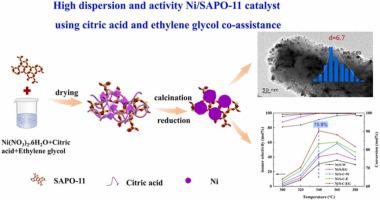Journal of Environmental Chemical Engineering ( IF 7.4 ) Pub Date : 2022-01-19 , DOI: 10.1016/j.jece.2022.107220 Lingmei Yang 1, 2, 3 , Wen Luo 1, 2, 3 , Hui wen Li 1, 2, 3 , Hai yong Wang 1, 2, 3 , Aihua Zhang 4 , Zhilian Wu 5 , Qiying Liu 1, 2, 3 , Zhongming Wang 1, 2, 3 , Pengmei Lv 1, 2, 3 , Zhenhong Yuan 1, 2, 3

|
A range of Ni/SAPO-11 catalysts was generated via citric acid impregnation using various solvents (water, ethanol, and ethylene glycol); these catalysts were employed to oleic acid hydrogenation for generating bio-aviation fuel. The catalysts were characterized through powder X-ray diffraction, low-temperature nitrogen adsorption–desorption, transmission electron microscopy, hydrogen temperature-programmed reduction, X-ray photoelectron spectroscopy, in-situ thermogravimetry-Fourier transform infrared, temperature-programmed desorption of ammonia, and pyridine-adsorbed infrared spectroscopy. It was observed that the type of solvent used for the preparation of catalysts influenced the Ni particle size of the catalysts. Notably, in the catalyst preparation process, citric acid as a chelating ligand and ethylene glycol as a solvent, can enhance the interaction between Ni and SAPO-11 support, leading to the formation of small nickel nanoparticles (6.7 nm), meantime with a large surface area and strong total acid content of 0.087 mmol/g. During oleic acid hydrogenation, the Ni/SAPO-11 catalyst with citric acid and ethylene glycol co-assistance impregnation exhibited excellent catalytic performance, with 99.9% conversion and 75.9% iso-alkanes (iso-C8-C18) selectivity. Particularly, to create more multibranched iso-alkanes and show stable catalytic performance after five runs.
中文翻译:

柠檬酸和乙二醇共助浸渍制备的高分散 Ni/SAPO-11 催化剂催化油酸加氢处理生物航空燃料
使用各种溶剂(水、乙醇和乙二醇)通过柠檬酸浸渍生成一系列 Ni/SAPO-11 催化剂;这些催化剂用于油酸加氢以生产生物航空燃料。通过粉末X射线衍射、低温氮吸附-脱附、透射电子显微镜、氢气程序升温还原、X射线光电子能谱、原位热重-傅里叶变换红外、氨的程序升温脱附对催化剂进行了表征和吡啶吸附红外光谱。据观察,用于制备催化剂的溶剂类型会影响催化剂的 Ni 粒径。值得注意的是,在催化剂制备过程中,柠檬酸作为螯合配体,乙二醇作为溶剂,可以增强 Ni 和 SAPO-11 载体之间的相互作用,导致形成小的镍纳米颗粒(6.7 nm),同时具有大的表面积和 0.087 mmol/g 的强总酸含量。在油酸加氢过程中,柠檬酸和乙二醇共助浸渍的Ni/SAPO-11催化剂表现出优异的催化性能,转化率为99.9%,异烷烃(iso-C8-C18)选择性为75.9%。特别是为了产生更多的多支链异烷烃并在五次运行后表现出稳定的催化性能。柠檬酸和乙二醇共助浸渍的 Ni/SAPO-11 催化剂表现出优异的催化性能,转化率为 99.9%,异烷烃(iso-C8-C18)选择性为 75.9%。特别是为了产生更多的多支链异烷烃并在五次运行后表现出稳定的催化性能。柠檬酸和乙二醇共助浸渍的 Ni/SAPO-11 催化剂表现出优异的催化性能,转化率为 99.9%,异烷烃(iso-C8-C18)选择性为 75.9%。特别是为了产生更多的多支链异烷烃并在五次运行后表现出稳定的催化性能。











































 京公网安备 11010802027423号
京公网安备 11010802027423号